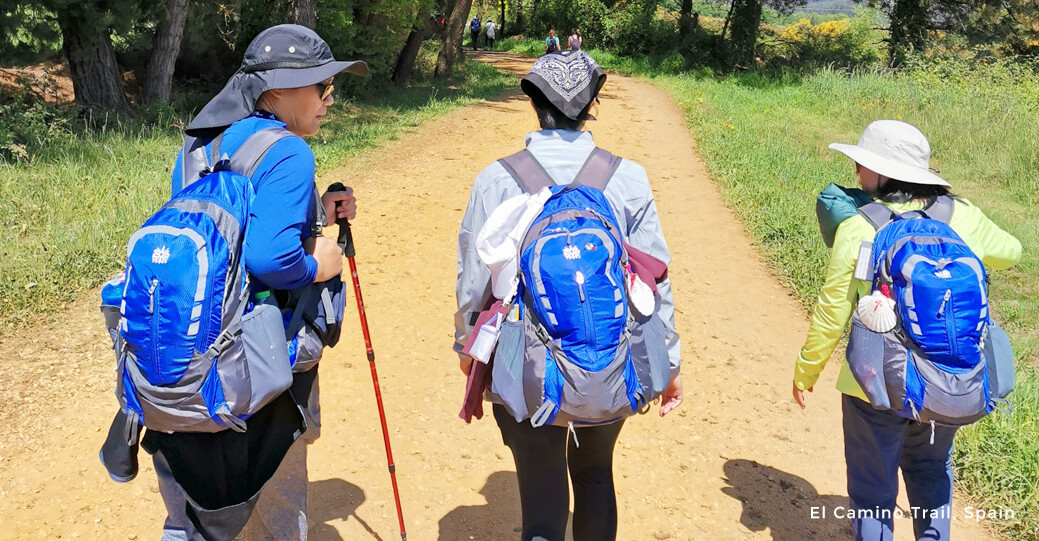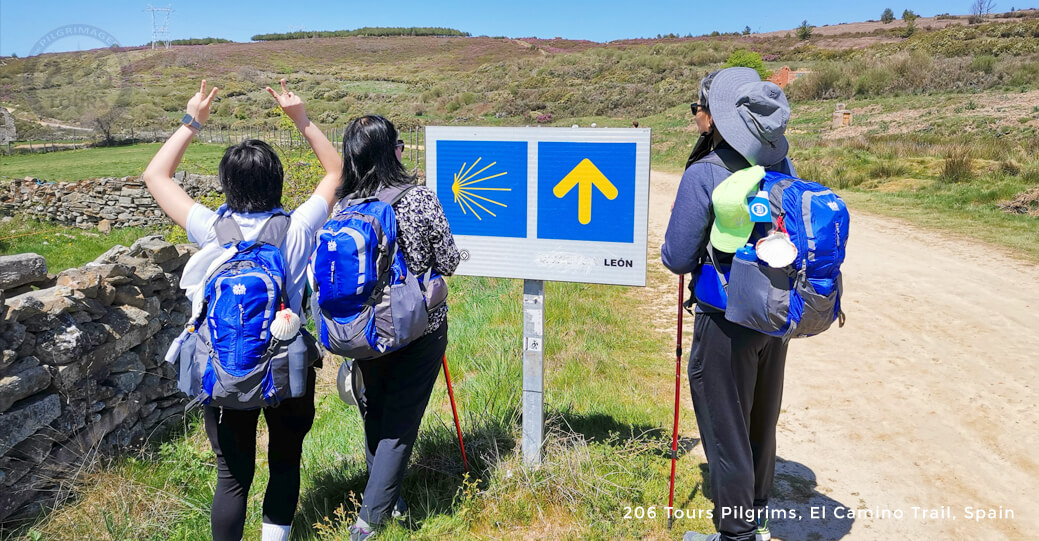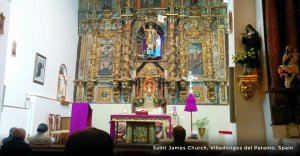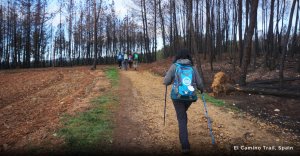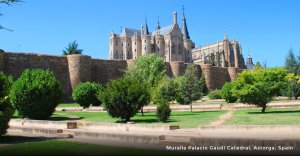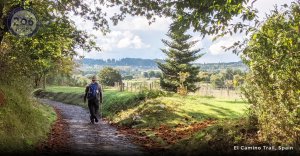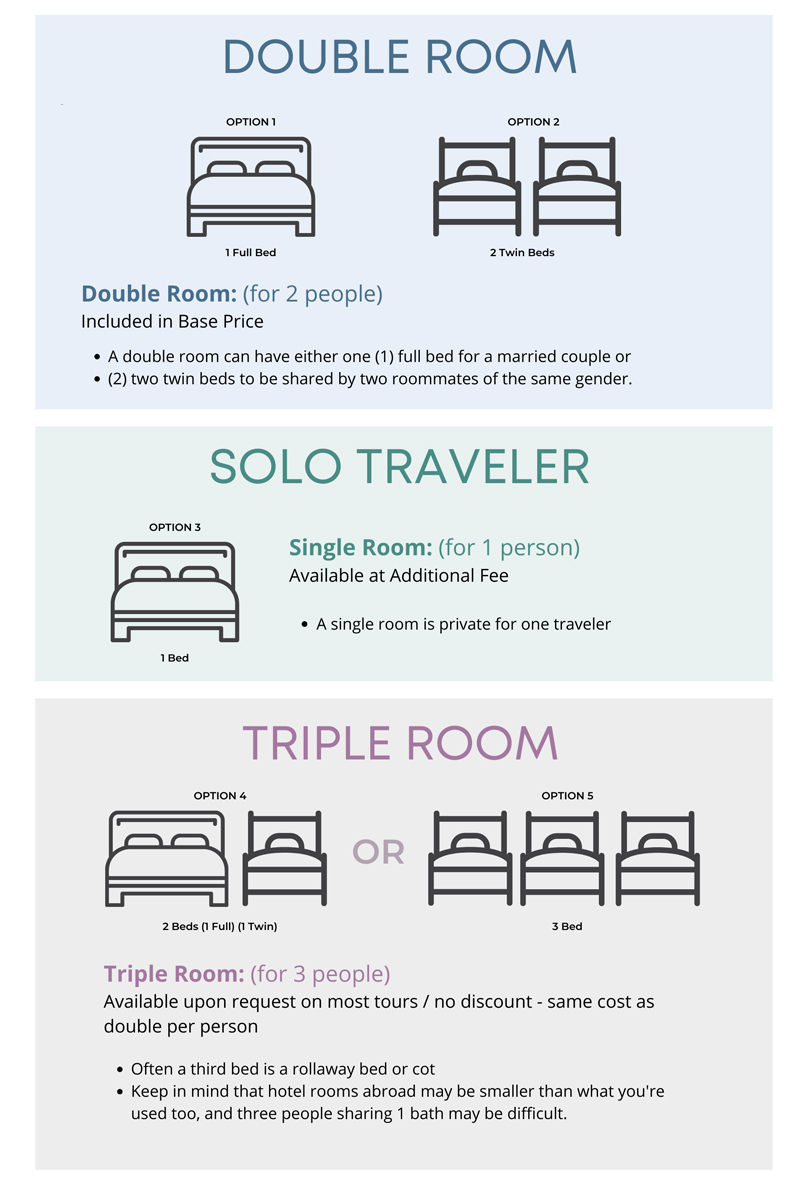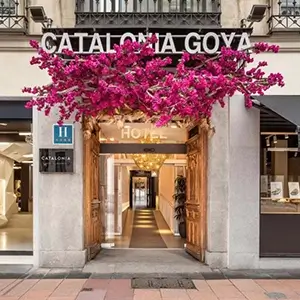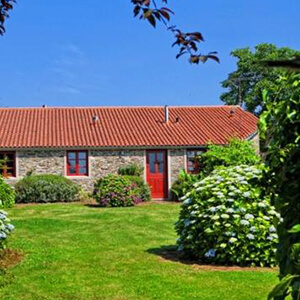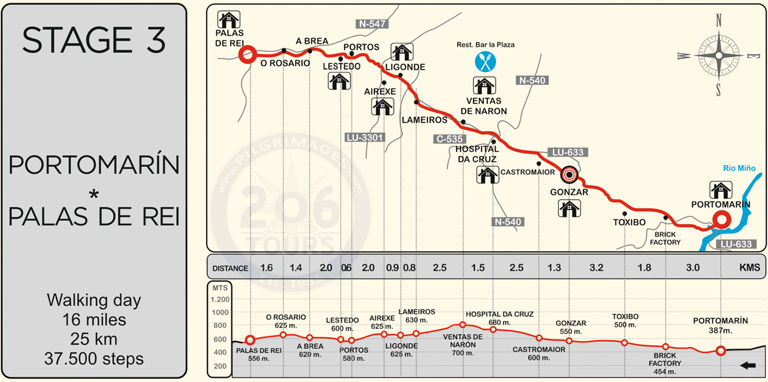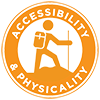Your trip includes
- Round-trip airfare from your desired Airport
- Catholic Priest
- Mass daily & Spiritual activities
- All airport taxes & fuel surcharges
- Hotel accommodations: (or similar) in double occupancy
- ~ 1 night: Catalonia Goya, Madrid, Spain
- ~ 2 nights: AC Hotel by Marriott Leon San Antonio, Leon, Spain
- ~ 2 nights: Hotel Spa Ciudad de Astorga By PortBlue Boutique, Astorga, Spain
- ~ 1 night: AC San Ponferrada, Astorga, Spain
- ~ 3 nights: Parador de Villafranca del Bierzo, Villafranca del Bierzo, Spain
- ~ 2 nights: Hotel Alfonso IX, Sarria, Spain
- ~ 1 night: Pousada de Portomarin, Portomarin, Spain
- ~ 1 night: Pazo Marinao, Palas de Rie, Spain
- ~ 2 nights: A Painza, Arzua, Spain
- ~ 1 night: Hotel Amenal, O Pino, Spain
- ~ 2 nights: Hotel Compostela, Santiago De Compostela, Spain
- Breakfast daily
- 13 Lunches
- Dinner Daily
- Professional local Catholic Tour Escort
- Guide Book of El Camino and Daily Maps
- Sightseeing and admissions fees as per itinerary
- Transportation by air-conditioned motor coach
- Free WiFi & Water on bus
- Vehicle available to assist pilgrims who are unable to complete any leg of the journey
- Porterage service at Hotels throughout
- Hotel taxes and service charges
El Camino Accommodations:
Please be advised that we book you in the best available accommodations that are along the Camino trail.
There are a limited number of places to stay along the Camino trail, without having to walk extra miles
away from the Trail, and then back to the Trail to continue walking the route. These places range in Star
Rating – simply because luxury hotels just do not exist.
Not Included
- Any meals not mentioned
Itinerary
While you will be removed from the routine of your everyday life, rest assured you will be taken care of with outstanding accommodations, meals and transportation with van / bus driving parallel to the path you walk each day. Should at any point you feel tired, need water, or any medical assistance, it will be readily available to you at check points that are set up along the way on your path. Tourists pass through places, places pass through Pilgrims.
*Important Notice:
This itinerary involves an average of 13 – 20 miles daily of walking/hiking. It is essential that participants be in fit condition in order to complete the journey. We will have assistance vehicles (motor coach) available to assist pilgrims who are unable to complete a particular leg of the journey.
Day 1: Depart USA
Board your overnight transatlantic flights from your hometown. Meals are served on board.
Day 2: Arrive in Madrid
Upon arrival in Madrid, you will collect your luggage in the baggage claim area, and continue to the Arrival’s Hall where you will be greeted by your driver. Transfer to your hotel. In the afternoon walk to the Cathedral of Almudena. Following Mass, we visit the Cathedral. We will continue our walking tour of Madrid to include the exterior of the Royal Palace. Walk through the Plaza Mayor and Puerta del Sol and we make a stop at the Church of Saint James. Return to your hotel. We will enjoy a nice meal before having a restful overnight in Madrid before your walking tour begins!
Day 3: Madrid – Burgos - Leon
After breakfast in the hotel, we will depart towards Burgos. Burgos has been on the pilgrim route to Santiago from the very beginning. In the old part of the city, we will find the remains of the old castle looking down onto the Gothic Cathedral of Saint Mary, declared a World Heritage Site in 1984. The building of the cathedral was commissioned in the 11th Century by King Fernando III and his German wife Beatrice of Swabia. The building of the cathedral was overseen by the English born Bishop Don Mauricio. The towers which dominate the skyline were designed and built by Hans of Cologne, bearing more than a passing resemblance to the great cathedral in Cologne. The cathedral is vast with a number of different chapels but perhaps one of the most interesting is the Chapel of the Christ of Burgos. Directly opposite this chapel above the Chapel of Santa Tecla you will find the Papamoscas. This is an automaton above a clock which opens and closes its mouth and strikes a bell on the hour. Also within the cathedral are buried the remains of Rodrigo Diaz de Vivar, better known worldwide as El Cid. Apart of the Cathedral we will find two very important monasteries in Burgos: The Monastery of Las Huelgas, a favourite place of retreat for the Castilian monarchs; and the Cartuja de Miraflores where now, a community of Carthusian monks live in silence. This afternoon, we will warm up our legs walking around 3 miles from Calzada del Coto to Bercianos del Real Camino or from Bercianos del Real Camino to El Burgo Ranero. At the end of the day, we will arrive in Leon. Lying on the banks of the Bernesga River, Leon is the last major city before we reach Santiago, and before we climb through the mountains of the Cordillera Cantabrica. The city was founded as a Roman fort in AD 68 to protect the roads leading west to the gold mines at El Bierzo. The town was home to the Legio Septima, or Seventh Legion of Imperial Rom,e from when the city is believed to get its name. Leon was Christianized in the 3rd century becoming the oldest Bishopric (diocese of a bishop) in Western Europe. Leon has impressive buildings like the Cathedral of Santa Maria, a gothic masterpiece. The building that stands here today was begun in the 13th century and built over the original Romanesque Cathedral. The Cathedral of Leon is well known worldwide due to its impressive stain glass windows, similar in quality to the ones in Chartres Cathedral. Other buildings we will find in Leon are: Casa Botines, built by the famous architect Antoni Gaudi, who designed the Sagrada Familia Basilica in Barcelona; the Royal Collegiate of San Isidoro; and the former pilgrim hospital and monastery of San Marcos. Dinner & overnight in Leon.
Day 4: Leon – Villadongos del Paramo
Breakfast in the hotel. After attending Mass in the Cathedral of Leon, we will stamp our pilgrim passport in the Cathedral to start our pilgrim walk towards Santiago de Compostela, following the scallop shells that pass by the Real Collegiate of San Isidoro and towards San Marcos. The first village we are going to find in our way is La Virgen del Camino (Our Lady of the Way). The Catholic tradition says that during the feast of the Visitation in July 1505, the Virgin Mary appeared to a local shepherd while he was taking care of his flock. She asked him to go to the city, to get the Bishop and to bring him to this place to build a shrine in her honor. He asked the Virgin Mary how was the Bishop to know that it was She that sent him. The Virgin Mary seeing that he had a slingshot in his hand asked him to pass it to her. She picked up a small stone and put it into the slingshot. She told the shepherd that wherever this stone landed that is where she wanted her shrine to be built. The shepherd set off to speak to the Bishop in Leon and told him of the apparition. He was unconvinced until the shepherd, using his slingshot, hurled a stone which promptly became a boulder when it struck the ground. Now convinced of the miracle, the Bishop built a hermitage dedicated to the Virgin Mary. The very modern church that stands in the place where the original hermitage had been is the Church of the Virgen del Camino which was built in 1961 and is managed by Dominican friars. After visiting the Virgen del Camino village, we will follow the old Roman road that linked Astorga with Leon. At the end of the stage, we will arrive at the village of Villadangos del Páramo, where we will find the Church of Saint James where at its entrance we will see a carving depicting the legendary battle at Clavijo in 844. It is at this battle that Santiago in his guise as Santiago Matamoros, is reputed to have helped the vastly outnumbered Christian army. Dinner and overnight in Leon.
Day 5: Villadongos del Paramo – Astorga
(walking day, 16.6 Miles / 22 km)
Breakfast in the hotel. After attending Mass at Saint James Church in Villadongos del Paramo, we will continue our walking pilgrimage. The first large village we will find today is Hospital de Orbigo, and to get to this beautiful village we will have to cross the longest bridge on El Camino (670 feet) and there is a nice story related to it: El Paso Honroso (The honorable pass). The name was given due to a jousting tournament of sorts undertaken by Don Suero de Quiñones. Don Suero was in love with a lady by the name of Doña Leonor de Tobar, who unfortunately did not feel the same way. This 15th century knight, who considered himself a prisoner of her love, decided to wear an iron collar around his neck every Thursday as a symbol of being enslaved by his love for her. As a way to impress both the lady he loved and King John II of Castile, as well as a way of freeing himself from his enslavement, he decided to embark on a surprising joust in the style of the knights of old. Don Suero offered the tournament to Saint James saying that he and nine other knights would challenge those undertaking the pilgrimage to Santiago until 300 lances were broken. When the tournament was finished, all the participants went to Santiago de Compostela to offer the arms with which they fought to the Apostle. The tradition says that the iron collar (that it was turned in gold) worn by Don Suero, is hung around the neck of the image of the Apostle that is used in processions. We will find the Church of Saint John the Baptist on the other side of the bridge, which is what remains of the pilgrim hospital which had been built in the 12th Century by the Knights of the Order of Saint John of Jerusalem. At the end of the stage, we will arrive to the walled city of, Astorga. This historical and religious city, called Asturica Augusta by the Romans, was one of the Roman strongholds in the Leon area. On it the French and the Plata Routes to Santiago converge. This extraordinary Gothic Cathedral from the 15th Century presides over the town; the Episcopal Palace or Gaudí Palace, houses the Museo de los Caminos, which displays pieces from all churches related to the Route to Santiago.; and the chocolate museum that celebrates Astorga chocolate industry which thrived during the 18th and 19th Centuries. Dinner and overnight in Astorga.
Day 6: Astorga – Rabanal del Camino
(walking day, 12.3 Miles / 19.7 km)
After breakfast in the hotel, we will attend Mass at the Cathedral of Astorga. Today we will walk through the area called: la Maragateria, ending in the Bierzo region that borders with Galicia. We will walk through Murias de Rechivaldo, a lovely village with most of the stone buildings constructed in the traditional Maragato style, and where we will find the Church of Saint Stephen. With a carving of Our Lady of the Pillar above its door; “Santa Catalina de Somoza”, there we will see the Church of Saint Mary that houses a relic of Saint Blaise, the town patron saint, and El Ganso, with its thatched houses which are typical of the North-Western part of Leon and Galicia. Before arriving to Rabanal del Camino, we will pass the remains of the Roman gold mines of La Fucarona, one of the oldest gold mines which made a cliché of Astorga´s wealth in Roman times. In the Middle Ages, Rabanal del Camino was an important stop for pilgrims before they walked through the mountains. It was a large settlement of the Templar Knights who used to defend and protect the pilgrims from the robbers of the harsh areas of Focebadon. There is a community of Benedictine monks living in the San Salvador del Monte Irago Monastery who came from Santo Domingo de Silos in 2001, although, now the monastery is affiliated with the abbey at St Otilien in Germany. Board bus for your return to Hotel in Astorga for dinner and overnight.
Day 7: Rabanal del Camino – Ponferrada
(walking day, 20.3 Miles / 32 km)
Breakfast in the hotel. After attending the Holy Mass at the Church of Saint Joseph (or at the Church of Our Lady of the Assumption), the bus will bring us to our departure point where we will continue our pilgrimage. After leaving Rabanal del Camino, the route continues across the region of Leon. The first village that appears is Foncebadon, the onetime important center in the Middle Ages that has been abandoned. Here took place a Council in the 10th Century, and a century later, the hermit Guacelmo founded a hostelry for pilgrims. Some kilometers off the municipality, surmounting a peak that the Romans dedicated to Mercury can be seen the Ferro Cross, on top of a stick fixed to a big heap of stones. Traditionally pilgrims bring a stone from their places of origin and deposit it on the heap. The end of our today’s journey is located in Ponferrada. This town, with Prehistoric and Roman antecedents, had two accesses in the Middle Ages. One was via the Roman bridge spanning the Boeza river, sunk in the 18th Century; the other was via the path of the Gallegos, and then crossing the river by the Medieval bridge of Mascarón. At the end of the 11th Century, the Bishop of Astorga, Osmundo, commissioned the building of a new bridge, “la Pons Ferrata”, a pass with iron banisters which gave name to the city. Later on, between the 11th and 14th Century, the Castle of the Knights Templar was built. In the 15th Century the Catholic Monarchs commissioned the construction of the Hospital de la Reina, next to the fortress. In this monumental town also stand the Basilica of Nuestra Señora de la Encina, built to commemorate the apparition of the Virgin in a grove of Holm oaks, and the Baroque church of San Andres, which is home to an outstanding retable: “The Christ of the Wonders”. Dinner and overnight in Ponferrada.
Day 8: Ponferrada – Villafranca del Bierzo
(walking day, 12.6 Miles / 20.2 km)
Breakfast in the hotel. After attending the Mass, we continue on our walking pilgrimage. Today, part of our journey will follow the old Roman road that connected Ponferrada with the silver and gold mines located in Las Médulas. The first, and last, village we will see today is Cacabelos. Cacabelos as a village that first appeared in the 10th Century, but it can trace its origins to way back in the Bronze Age. In the Middle Ages, the town boasted few churches and some pilgrim hospitals, but nothing remains of these ancient buildings except the 18th Century the Quinta Angustia Shrine, where we will find a very unusual carving of the child Jesus playing cards with Saint Anthony of Padua, which was built on the site of one of the medieval hospitals. At the end of the stage, we will arrive to Villafranca del Bierzo, the last major town along the Camino de Santiago in Leon, with the Galician village of O Cebreiro only 17 miles away. Villafranca del Bierzo is believed to have been founded by French monks of the Cluny order. The town could be said to owe its existence to El Camino and the many monuments founded here that make Villafranca del Bierzo a natural tourist destination. There is plenty to see, but the most interesting buildings/monuments are: The Church of Saint James (that granted the privilege of providing absolution to the pilgrims who were too ill to continue along the Camino to Santiago), San Nicolas (founded as a religious school run by Jesuits until their expulsion in 1767), The Collegiate of Saint Mary ( which was built on the site of the original monastery of the Cluny order), The Agua Street (full of palaces and emblazoned houses), The San Francis Church, and the Castle of the Marquees of Villafranca. Board your bus for your return ride to your Hotel in Villafranca del Bierzo for dinner and overnight.
Day 9: Villafranca del Bierzo. Resting day
Breakfast in the hotel. We will dedicate our day to rest and enjoy this beautiful town. Dinner and overnight in Villafranca del Bierzo.
Day 10: Villafranca del Bierzo – O Cebreiro
(walking day, 17.2 Miles / 27.6 km)
Breakfast in the hotel. After attending Holy Mass, we will continue our pilgrimage. During the morning, we will walk through the Ancares Valley area where we will be able to see the Castles of Sarracín (which some ruins can be seen), and Veiga; both castles are connected to Celtic legends. Half way through our walk, we will arrive to the village of Vega de Valcarce where we will find a great example of an “horreo” or grain store. As we enter in Galicia, we will see different horreo styles, usually made of granite or wood. The Camino, from this point until we get to O Cebreiro, will consist of climbing up through the mountains with the terrain starting off gently but progressively getting steeper. O Cebreiro, with an altitude of almost 4,000 feet, owes much of its existence to the Camino de Santiago, as well as to the many roman roads that passed this way. It is the first town we reach on the French Camino as we enter Galicia. The first pilgrim hospital to appear in the town was built in the 9th Century and was run from the late 11th Century by the monks of Saint Gérard De’Aurillac, a French religious order. Also in the 9th Century, the monastery of the Sanctuary of O Cebreiro was built, not much remains other than the Church of Saint Mary the Royal, considered to be the oldest intact church along the whole Camino. There is an Eucharist miracle related to this church. In the 14th Century there was a parishioner from a nearby village called Barxamaior, who climbed up to the church through heavy snow and a blizzard in order to hear Mass. As the priest was performing the Eucharist, he had a momentary lapse of faith and whilst he was consecrating the bread and wine he thought to himself, whilst looking at the parishioner sat in front of him “what is this man doing here in this cold weather, just to see a piece of bread and a little wine?”. It was at this point that the miracle occurred, the bread turned to flesh and the wine became blood. This became known locally as the Galician Holy Grail. The relics are kept in the church in a reliquary given to the church by the Catholic Monarchs whilst they were undertaking the Camino to Santiago in 1486, along with the chalice and paten used in that Mass. While we are here in O Cebreiro we will be able to take a look at the Pallozas, the traditional round stone houses with thatched roofs that the people of this area used as their homes. Board your bus for your transfer to your Hotel for dinner and overnight in Villafranca del Bierzo.
Day 11: O Cebreiro – Triacastela
(walking day, 17.2 Miles / 27.6 km)
Breakfast in the hotel. After attending the Holy Mass at Saint Mary the Royal Church, the bus will transfer you to your departing point and we will continue our pilgrimage towards Santiago. In Galicia, we will pass through countless hamlets connected to one another by ancient dry-stone walls separating the trail from an endless patchwork quilt of worked fields and cow pastures. We’ll enjoy the hearty Galician fare – including leafy green soup, called “caldo gallego”, creamy cow’s milk cheeses, thick, round loaves of wheat, rye and corn meal bread, outstanding Galician veal and pork, seafood and greens – cabbage, broad beans, Swiss chard and leeks. Our halt today will be Triacastela. In the 13th Century, Alfonso XI tried unsuccessfully to convert this precious village into a big town. Triacastela once had a hospital and a prison, an unusual circumstance along the Route. Pilgrims can visit the Parish Church of Santiago, containing a façade from the 18th Century and a Romanesque apse. In its interior there is a processional cross from the 12th Century. As a penance, pilgrims used to carry in their packs a limestone from the mountains of Triacastela. Dinner and overnight in Sarria.
Day 12: Triacastela – Sarria
(walking day, 13 Miles / 20.9 km)
Breakfast in the hotel. After attending the Holy Mass we will continue our pilgrimage. Today, on our halfway to Sarria, we will get to the town of Samos where we will find the impressive Benedictine Monastery of San Julian de Samos. It was founded in the 6th Century by San Martin Dumiense, and renovated by San Fructuoso in the 7th Century. Unfortunately, soon after the monastery was renovated, it was abandoned because of the Moorish invasion and it wasn’t until the Christian King Fruela I reconquered the area did the monks return. This important monastery is situated on the valley by the Ouribio River, surrounded by a scenery that enhances its beauty and provides a mysterious atmosphere. Its impressive Neoclassical façade is worthy of note, as well as the huge cloisters. The cloister of Nereidas, from the 16th Century contains a beautiful fountain. The Cipres chapel, from the 10th Century, is one of the oldest elements in the monastery. Back on the Route, we will pass through a picturesque scene full of oaks and chestnut trees. At the end of the stage, we will arrive to Sarria. Sarria has been inhabited for many thousands of years both by the Celts and the Romans but the town was founded at the end of the 12th Century by King Alfonso IX, the last King of Leon. He unfortunately died here in 1230 from a serious illness that he contracted as he was undertaking the pilgrimage to Santiago. Most of the buildings linked to El Camino can be found behind the main street on the hill where the old town used to be, like the Church of Salvador (with a Romanesque ground plan and Gothic façade), the small chapel of San Lazaro, the hospital of Saint Antony (which today houses a Court), the remains of its old fortress from the 14th Century, and the Monastery of La Magdalena (founded by a couple of Italian friars, belonged to the Penance of the Venerable Martyrs of Christ, who passed this way on their pilgrimage to Santiago, and that is now managed by the Religious Order of the Mercy of Christ). Dinner and overnight in Sarria.
Day 13: Sarria - Portomarin
(Walking Day: 16 miles | 25.7 kilometers | 38,000 steps)
Today is the day that your walking pilgrimage (El Camino) to Santiago de Compostela officially begins! With the guidance of Our Lord, and through the spirit of St. James the apostle, you will become an authentic pilgrim by journeying along the physical road, as well as, the spiritual one. Your first official day of walking will culminate in Portomarin. This town dates back to the Roman Ages and was an important halt along the route in the Middle Ages. Due to the creation of a dam in 1962, the Old Portomarin is currently underneath the Mino River. As a result of the dam creation, many of the old buildings were moved, brick by brick. Among these buildings is the Church of St. John of Jerusalem. In Medieval Times, this church was strategically set along the route of El Camino in order to protect the tomb of Santiago. At Portomarin, you will enjoy dinner followed by an overnight.
Day 14: Portomarin - Palas de Rei
(Walking Day: 18 miles | 28.9 kilometers | 42,000 steps)
This morning, you will enjoy breakfast at your hotel and journey from Portomarin, through the woods to the Palas de Rei. This was a noteworthy town in the Middle Ages, as it contained a Royal Hospital and the church of St. Tirso. As the rugged walk continues, you will continue through fields, forests, and granaries. Additionally, you will see a prominent characteristic of Galician Landscape, Los Cruceiros. These wayside crosses depict Christ and the Virgin Mary. Dinner and enjoy a restful overnight in Palas de Rei.
Day 15: Palas de Rei - Arzua
(Walking Day: 19 miles | 30.5 kilometers | 44,500 steps)
Breakfast will be served at your hotel. Your pilgrimage continues as you will travel from Palas de Rei to the bustling small town of Arzua. Before arriving in Arzua, your group will stop at Melide. This town is a crucial point of El Camino because it is where the French and Oviedo routes converge. Upon arrival in Melide, you will notice the old roads that date back to the fourteenth century, which are some of the oldest in the region of Galicia. After lunch, you will leave the Lugo province and enter into the province of A Coruna. As your group continues to Arzua, you will cross the beautiful, medieval bridge over the Iso River to Ribadiso. Following your visit to this Chapel, your day will culminate with the arrival in Arzua, where you will enjoy dinner and an overnight.
Day 16: Arzua
(Rest Day: 4.5 miles | 7.2 kilometers | 10,500 steps)
Today, you will take a break to rest your bodies and shake off any fatigue. After Mass, there will be time to reflect on the journey thus far and to spend at your own leisure. Dinner and overnight will be provided in Arzua.
Day 17: Arzua - Arca de O Pino
(Walking Day: 16 miles | 25.7 kilometers | 37,700 steps)
Your journey is almost over as you will walk to the largest community before Santiago, Arca de O Pino! Upon walking this route, you will immerse yourselves in the fragrant eucalyptus groves and experience the breathtaking scenery. At a point throughout your walk, you will stop and enjoy a picnic lunch. Following lunch, you will continue your journey and arrive in Arca de O Pino. As you explore this village, you will notice joy etched on the faces of the pilgrims. Although they have traveled a long distance, they are not weary. With God and St. James guiding their paths, excitement, and anticipation continues for their arrival in Santiago.
Day 18: Arca de O Pino - Monte del Gozo - Santiago de Compostela
(Walking Day: 16 miles | 25.7 kilometers | 37,700 steps)
Today, you will culminate the walking portion of your journey! Before arriving at your final destination, you will first stop for Mass on Mount Joy (Monte del Gozo). You will know that you are approaching Santiago because, at this point, you will be able to see the spires of the Cathedral. Following lunch, you will complete your walking journey and arrive at the Cathedral of Santiago de Compostela. Upon arrival, feel free to say a small prayer in thanksgiving to Our Lord for keeping you safe throughout the walking pilgrimage. At this time, you will check-in to your hotel and enjoy free time to explore Galicia’s capital, Santiago. This evening you will enjoy a marvelous dinner, followed by a very restful overnight in Santiago de Compostela.
Day 19: Santiago de Compostela
This morning you will awaken in the beautiful city of Santiago de Compostela! Formed by Galician granite, this Cathedral is one of the finest architectural examples in Europe as it encompasses Romanesque, Gothic and Baroque styles. Additionally, the Cathedral contains numerous and valuable pieces of art that truly captivate the eye. Upon entering the Cathedral, the tradition will lead as you will hug the dazzling statue of St. James. Following this intimate embrace, you will descend into the crypt where the Patron Saint of Pilgrims’ relics is kept. Following your visit, you will enjoy free time for lunch on own before your sightseeing tour of the city. Some stops on your tour include the Obradoiro Square, Fonseca Palace, Gelmirez Palace, Franco Street, and much more. Your evening will be free to spend at your leisure until a final dinner with your group. You will spend a final overnight in Santiago de Compostela.
Day 20: Return Home
Your last day in Spain will begin with breakfast at your hotel, followed by a transfer to the Santiago Airport for your return flight(s) home. You will say hasta luego (see you later) to your new friends made on this journey.
*206 Tours Disclaimer:
Occasionally local religious and national holidays, weather, traffic conditions and other events may necessitate changes in the sequence of events or the missing of certain events/places. Though every effort will be made to follow the itinerary, it should be considered as an indication, rather than a contract of events and places to be visited.
*Important Notice:
This itinerary involves an average of 13 – 20 miles daily of walking/hiking. It is essential that participants be in fit condition in order to complete the journey. We will have assistance vehicles (motor coach) available to assist pilgrims who are unable to complete a particular leg of the journey.

Special Clergy Discount
A Clergy Discount is available to all members of “Clergy” within the Catholic Church. This includes Seminarians, Deacons, Brothers and Sisters, Priests, Monsignors, Bishops, Cardinals, and His Holiness.

Earn a Free Trip
For groups of 20 or more, you may choose your own departure and earn FREE trips.







